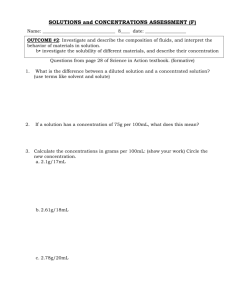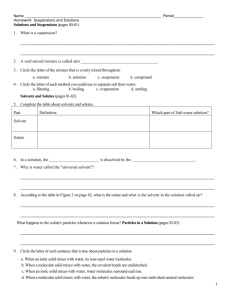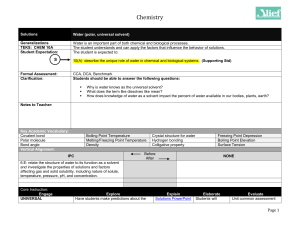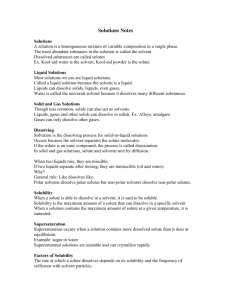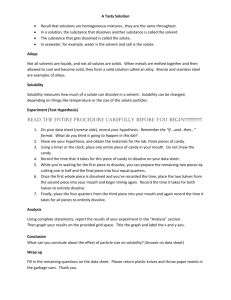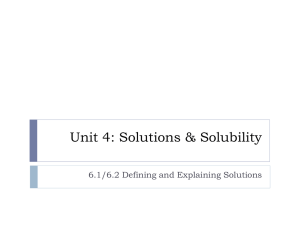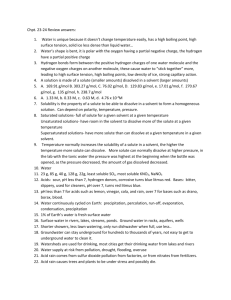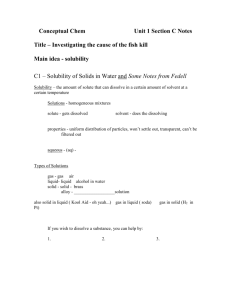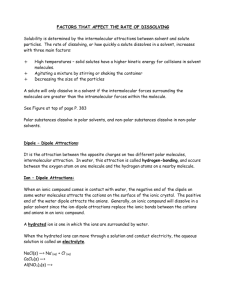PowerPoint - Solution Concentration - Mol/L, W/V
advertisement
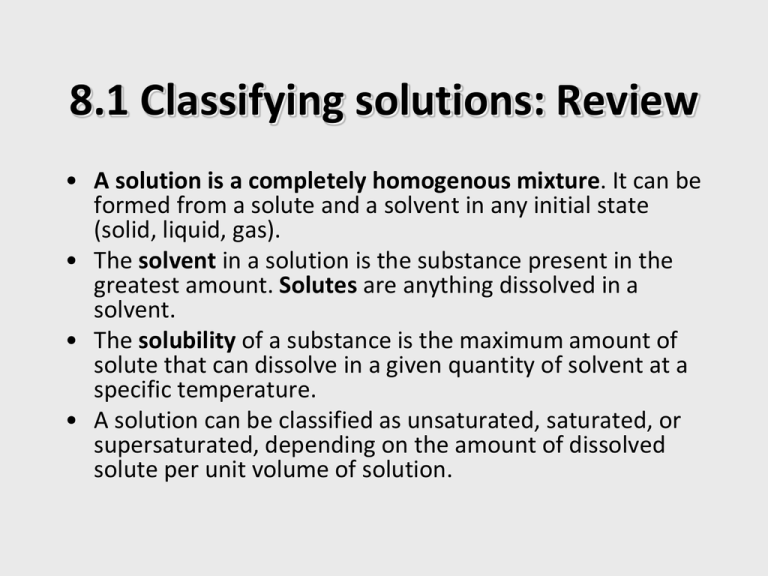
8.1 Classifying solutions: Review • A solution is a completely homogenous mixture. It can be formed from a solute and a solvent in any initial state (solid, liquid, gas). • The solvent in a solution is the substance present in the greatest amount. Solutes are anything dissolved in a solvent. • The solubility of a substance is the maximum amount of solute that can dissolve in a given quantity of solvent at a specific temperature. • A solution can be classified as unsaturated, saturated, or supersaturated, depending on the amount of dissolved solute per unit volume of solution. 8.2 Factors that affect solubility and the rate of dissolving: Review • Intermolecular forces affect solubility. • Water is a good solvent because it can dissolve a range of solutes due to partial dipoles and hydrogen bonding. • Ionic compounds that contain ions with relatively large charges or small radii tend to be insoluble in water. • Measuring conductivity can tell you whether solutes in a solution are ionic or molecular; ionic solutions are conductive, molecular are not. • “Like dissolves like” Polar solvents dissolve ionic and polar molecules; Non-polar solvents dissolve non-polar molecules. • Solubility is affected by temperature (solid in liquids vs gases in a liquid) and pressure (of a gas above liquid solvent) • The rate of dissolving a solid solute in a liquid solvent is affected by temperature, the surface area of the solute, and agitation. Solution Concentration Concentration = quantity of solute quantity of solution (not solvent) There are 3 basic ways to express concentration: 1) percentages 2) very low concentrations, and 3) molar concentrations 1) % concentration can be in V/V, W/W, or W/V • Like most %s, V/V and W/W need to have the same units on top and bottom. • W/V is sort of in the same units; V is mostly water and water’s density is 1 g/mL or 1 kg/L e.g. 3 g H2O2/100 mL solution 3 g H2O2/100 g solution Solution Concentration 2) Expressing concentrations in parts per million (ppm) requires the unit on top to be 1,000,000 times smaller than the unit on the bottom E.g. 1 mg/kg or g/g • Multiples of 1000 are expressed in this order _, m_, _, k_ (“_” is the base unit; g or L) • Notice that any units expressed as a volume must be referring to a water solution (1L = 1kg) • For parts per billion (ppb), the top unit would have to be 1,000,000,000 times smaller 3) Molar concentration is the most commonly used in chemistry. Ensure that units are mol/L. Recap & Examples Concentrations are expressed as a percent (V/V, W/V, W/W), as very low concentrations, or by molar concentration • % V/V = 4.1 L / 55 L = 7.5% V/V • % W/V = 16 g / 50 mL = 32% W/V • % W/W = 1.7 g / 35.0 g = 4.9% W/W • 8 ppm = 8 _ / 1 L, the units should be 1 million times smaller than 1L (or 1kg): 8ppm = 8 mg/L so the mass in 1 L is 8 mg. • 3.2 mg/0.59 kg = 5.424 mg/kg = 5.4 ppm • a) ppb is 1000 times smaller than ppm b) 1 g/109 mL, 1 mg/1000 L, 1 g/L, 1 mg/kL, 1 mg/Mg, 1 g/kg 8. 0.11 mol / 0.060 L = 1.8 mol/L Practice Questions 1. What is the % W/W of copper in an alloy when 10 g of Cu is mixed with 250 g of Zn? 10 g / 260 g = 3.8 % W/W 2. What is approximate % V/V if 30 mL of pure ethanol is added to 250 mL of water? 30 mL / 280 mL = 11% V/V 3. What is the % W/W if 8.0 g copper is added to enough zinc to produce 100 g of an alloy? 8.0 g / 100 g = 8% W/W To study this section, do Practice Problems (answers on the back)


